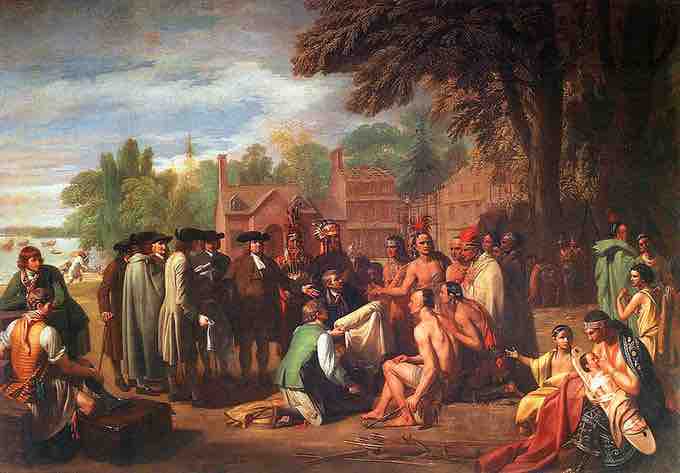During the American Revolution, the newly proclaimed United States competed with the British for the allegiance of American Indian nations east of the Mississippi River. Most American Indians who joined the struggle sided with the British, based both on their trading relationships and hopes that colonial defeat would result in a halt to further colonial expansion onto American Indian land. Other native communities were divided over which side to support in the war and others wanted to remain neutral. The first American Indian community to sign a treaty with the new United States Government was the Lenape. For the Iroquois Confederacy, based in New York, the American Revolution resulted in civil war. The only Iroquois tribes to ally with the colonials were the Oneida and Tuscarora.

The Treaty of Penn with the Indians by Benjamin West, painted in 1771
The Treaty of Penn with the Indians
Frontier warfare during the American Revolution was particularly brutal and numerous atrocities were committed by settlers and native tribes alike. Noncombatants suffered greatly during the war. Military expeditions on each side destroyed villages and food supplies to reduce the ability of people to fight, as in the frequent raids by both sides in the Mohawk Valley and western New York. The largest of these expeditions was the Sullivan Expedition of 1779, in which American colonial troops destroyed more than 40 Iroquois villages to neutralize Iroquois raids in upstate New York. The expedition failed to have the desired effect, as American Indian activity became even more determined.
The British made peace with the Americans in the Treaty of Paris (1783), through which they ceded vast American Indian territories to the United States without informing or consulting with the American Indians. The Northwest Indian War was led by American Indian tribes trying to repulse American colonists. The United States initially treated the American Indians, who had fought as allies with the British, as a conquered people who had lost their lands. Although most members of the Iroquois tribes went to Canada with the Loyalists, others tried to stay in New York and western territories to maintain their lands. The state of New York made a separate treaty with Iroquois nations and put up for sale 5 million acres (20 thousand km2) of land that had previously been their territories. The state established small reservations in western New York for the remnant peoples.